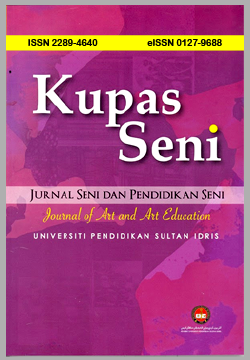Validity and Reliability of a Needs Analysis Questionnaire Instrument for The Development of DiD-Art Applications for Drawing Art in Secondary Schools
Kesahan dan Kebolehpercayaan Instrumen Soal Selidik Analisis Keperluan Pembangunan Aplikasi DiD-ART Untuk Seni Lukisan di Sekolah Menengah
DOI:
https://doi.org/10.37134/kupasseni.vol11.1.3.2023Keywords:
validity, reliability, instrument, application, visual arts educationAbstract
This study focuses on examining the validity and reliability of the instrument to evaluate the questionnaire used in the study. The questionnaire instrument that was built was adapted from a study by Amani Dahaman, (2014). Each item is modified according to the suitability of this study which is to evaluate the development needs of the DiD-Art application for the Drawing Art topic in secondary schools. Face validity and content validity are determined through the distribution of questionnaires distributed to experts. Five experts were involved in giving feedback on the items developed from the aspects of word, language and sentence selection and verifying each domain of the content developed. The research instrument was evaluated by five experts and a pilot study was conducted on 20 Visual Arts Education teachers. The Statistical Package for Social Science (SPSS) version 26.0 software was used to find Cronbach's alpha reliability coefficient values for each item. Findings show that Cronbach's alpha coefficient value is at α =.976. This shows that all the items built have gone through the measurement phase, have a high reliability value and are suitable for use as a measurement tool in assessing the development needs of the application to be developed.
Downloads
References
Amani, D. @ D. (2014). Pembangunan Modul M-Pembelajaran Bahasa Arab Di Institut Pendidikan Guru. University of Malaya.
Azimah, A. S. (2016). Penghasilan Catan Digital Dalam Pendidikan Seni Visual Murid Tingkatan Empat [UM]. http://studentsrepo.um.edu.my/11511/1/Samsuddin.pdf
Chua, Y. P. (2016). Mastering Research Methods (2nd ed., Issue May). McGraw-Hill.
Daud, Z., Hasin, A., Alias, N., & Hasbollah, S. (2017). Persepsi Pelajar Terhadap Penggunaan Aplikasi Al-Quran Dalam Telefon Pintar. Universiti Sains Islam Malaysia, 2070(July), 157–166.
Fraenkel, J. R., Wallen, N. E., & Helen H.Hyun. (2012). How to Design and Evaluate Research in Education (8th ed.). McGraw-Hill.
Hisyam, A. (2020). Kepentingan Pendidikan Seni Visual Sebagai Alat Komunikasi, Ekspresi, Kemahiran, Pengetahuan Dan Kefahaman & Menajamkan Kepekaan Pengamatan Kepada Murid-Murid Dan Masyarakat.
Ibrahim, N. F. S. C., Rusli, N. F. M., Shaari, M. R., & Nallaluthan, K. (2021). Persepsi Pelajar Terhadap Aplikasi Multimedia Interaktif dalam Proses Pengajaran dan Pembelajaran Abad ke-21. Online Journal for TVET Practitioners, 6(1), 14–24.
John W Creswell. (2008). Educational Research: Planning, Conducting, and Evaluating Quantitative and Qualitative Research (4th ed.). Pearson Prentice Hall.
Kementerian Pendidikan Malaysia. (2017). Dokumen Standard Kurikulum dan Pentaksiran Tingkatan 3. In Kementerian Pendidikan Malaysia.
Lee Hoi Yeh. (2021). Cabaran yang dihadapi Pendidikan Seni Visual dengan Pentaksiran Bilik Darjah di sekolah rendah daerah Hilir Perak. Jurnal Seni Dan Pendidikan Seni, 9(1), 46–57.
Lily Hanefarezan, A., Mimun Aqsha, L., Ashinda, A., & Mus’ab, S. (2018). Kesahan dan Kebolehpercayaan Instrumen Strategi Pembelajaran Kolokasi Bahasa Arab: Analisis Menggunakan Model Rasch (Validity and Realibility of Arabic Collocation Learning Strategies Instrument: Analysis Using Rasch Model). Jurnal Pendidikan Malaysia, 43(03), 131–140. https://doi.org/10.17576/jpen-2018-43.03-14
Lynn, M. R. (1986). Determination and Quantification Of Content Validity. Nursing Research, 35(6), 382–386. https://doi.org/10.1097/00006199-198611000-00017
Mohd Aizat, A. H. (2017). Tinjauan Masalah Guru Dalam Pengajaran Dan Pembelajaran Pendidikan Seni Visual. 1050, 3–8.
Mohd Aizat Abu Hassan., & Nur Raihan Mohd Yusof. (2018). Tinjauan masalah guru dalam pengajaran dan pembelajaran Pendidikan Seni Visual. 1(1), 1–11.
Mohd Nor, R., Nik Yusoff, N. M. R., & Haron, H. (2020). Meneroka Kaedah Pengajaran Guru Cemerlang Pendidikan Seni Visual Selangor (GCPSV): Satu Kajian Kes. Malaysian Journal of Social Sciences and Humanities (MJSSH), 5(5), 125–140. https://doi.org/10.47405/mjssh.v5i5.394
Muhammad Nidzam, Y. (2016). Pembangunan Model Kurikulum M-Pembelajaran Teknologi Dalam Pengajaran Dan Pembelajaran di IPG.
Sabariah, M. (2021). Cabaran Generasi Era Digital. Sinar Bestari. https://sinarbestari.sinarharian.com.my/komuniti/cabaran-generasi-era-digital/
Sanchez-franco, M. J., & Roldán, J. L. (2010). Computers in Human Behavior Expressive aesthetics to ease perceived community support : Exploring personal innovativeness and routinised behaviour as moderators in Tuenti. 26, 1445–1457. https://doi.org/10.1016/j.chb.2010.04.023
Treece, Eleanor Mae Walters.; Treece, J. W. (1982). Elements of Research in Nursing (3rd ed.). St.Louis : Mosby.
Yusoff, S. H. H. M., & Halim Husain. (2020). Penggunaan Perisian Aplikasi Teknologi Maklumat Dan Komunikasi Meningkatkan Integrasi Domain Pembelajaran Dalam Karya Murid Belajar Gaya Visual. Penyelidikan Dedikasi, 18.
Downloads
Published
Issue
Section
License
Copyright (c) 2023 Maznah Salleh, Mohd Zahuri Khairani, Yakup Mohd Rafee

This work is licensed under a Creative Commons Attribution-NonCommercial-ShareAlike 4.0 International License.





